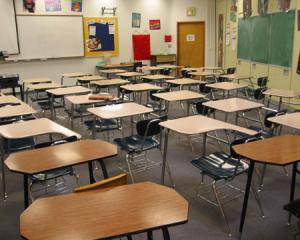
The amount has shocked Otago principals, who say it is money directed away from classroom teaching, and it is harming children's education.
Figures released under the Official Information Act reveal the Government provided $11,206,056.73 over and above the amounts already spent by schools from their operating budgets, to repair damage done by vandalism and graffiti.
Otago schools accounted for a fraction of the total with only an extra $41,253.97 needed in the past five years.
''It's a really unfortunate cost to schooling that we're having to spend money on what is really a social problem.
''They [vandals and taggers] are harming children's education. That's a lot of money out of our education portfolio.''
Ministry of Education infrastructure service head Kim Shannon said schools covered routine vandalism and graffiti costs through their operating grants, but when a school was faced with particularly high costs for vandalism or graffiti, the ministry provided top-ups.
Schools are allocated funding for repairs and maintenance based on their risk of receiving damage.
Mrs Madden said that most Otago primary schools were in the low-risk category, and set aside between $200 and $500 in their operations grant funding to repair damages.
''It's not an awful lot.''
The only time she had applied for a top-up was when she was at Halfway Bush School and all the copper spouting was stolen from its buildings, she said.
''The ratbags!''The top-up helped pay for the extra resourcing needed to fix it.''
Otago Secondary Principals' Association chairman Mason Stretch said every secondary school's damage repair budget was different and he had no idea how much each had set aside.
Schools had an idea of what was likely to happen each year in terms of vandalism and graffiti, but sometimes they had to apply for top-ups to help pay for significant ''one-off'' incidents, he said.
''A broken window or some spray-painting on a school's wall could easily be repaired using funds set aside in the budget, but if it was a significant one-off event - something that doesn't normally happen - that may require a top-up to cover the cost of repair,'' he said.
''Sometimes, vandalism is very hit-and-miss. It might happen once - we had an incident six years ago - but we've had nothing since.''
During the past five years, annual nationwide top-up figures had decreased from $2.9 million in 2009, to $1.67 million in 2013.
Ms Shannon said it was difficult to attribute the apparent decline to any one factor, but believed it was likely a combination of more effective school security measures and increased community crime prevention.
''It is also possible that schools which have experienced vandalism have had their risk category and funding raised, and so no longer need top-ups, even though they may be spending more than they had previously.''
Both Mr Stretch and Mrs Madden said that Otago schools were investing in security cameras, lighting and fencing, as well as better alarm systems, to deter vandalism and graffiti.
''Those things dramatically reduce vandalism and graffiti,'' Mr Stretch said.
''There are things schools can do to mitigate or reduce the effects of vandalism happening.''
Mrs Madden said some Otago primary schools were also rostering people from their community to walk through the school so that there was a security presence, particularly during the holidays.
Mr Stretch said members of the public often wandered through school grounds, but he believed schools were ''technically'' private property.
''If it is security fenced, people wouldn't be allowed inside. They [schools] have made a clear statement.''






